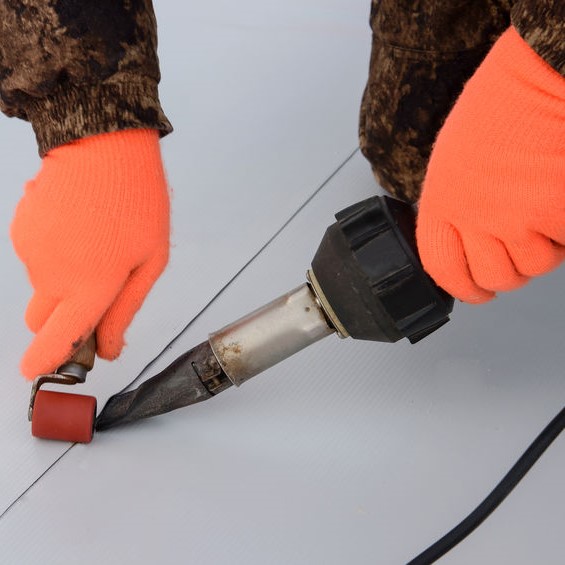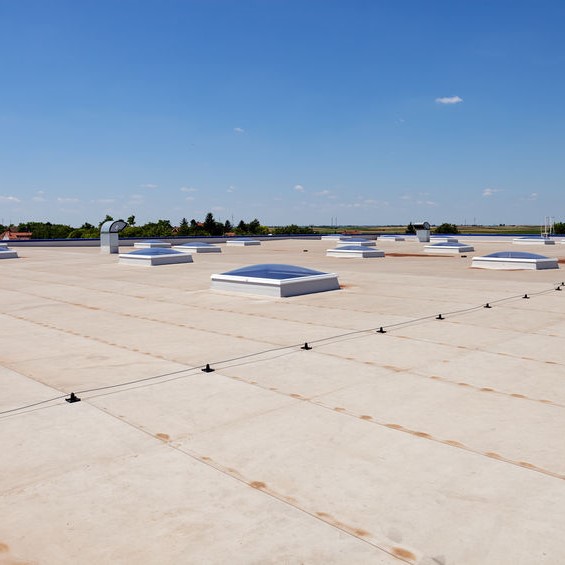
Flat roofing for your property
If you aren’t that well versed in TPO roofing, you may not know what TPO roofing material is precisely, so we’ll start this article off with TPO roofing explained, then answer some questions. Once you have read this piece, including TPO roofing benefits, you’ll have a better understanding of why it is approximately 40% of roofing market share.
TPO is the acronym for Thermoplastic Polyolefin, a single-ply roofing membrane. TPO roofing material is gaining popularity in the world of commercial roofing systems for several reasons. Starting with a single layer of synthetics, it is reinforced scrim, creating a membrane manufactured in lengths of 10 feet, 12, feet, and 20 feet wide sheets. The sheets are then rolled up and delivered to the job site.
TPO roofing has shown to be one of the best materials for roofing flat roofs, typically commercial structures, because of its naturally reflective surface that reflects UV rays. This reflectiveness helps in cutting down on the energy costs for cooling a commercial structure.
Is TPO better than EPDM?
Commercial roofing is unlike residential roofing in the fact that commercial roofing is typically flat roofing that covers larger areas than residential roofing. A flat roof doesn’t do well as a shingled because of water drainage. Therefore, they are either an EPDM (ethylene propylene diene monomer) or a TPO (thermoplastic polyolefin) roof system.
For 50 years or longer, the leader for commercial structure roofing has been EPDM roofing systems, but with TPO roofing on the scene now, it has gained popularity industry-wide. Why has TPO roofing gained this much attention? Because of the advantages and benefits, it offers:
- Energy Efficiency: TPO roofing reflects the sun’s UV rays, easing the workload on the air conditioning. In areas of the country where summers are brutal, the dark surface of EPDM roofing absorbs the UV rays and heat, and the air conditioner has to work harder and longer.
- Puncture and Tear Resistant: TPO roofing has three times higher puncture resistance than EPDM, meaningless leaks when it rains.
- Less Expensive Installation: business owners choose TPO roofing because of the low cost to install. There are fewer seams, making the install job quicker, meaning it requires less labor.
- Durable: TPO roofing has a permanent resistance against algae, bacteria, chemicals, debris, and dirt.
How thick is TPO roofing?
The TPO roofing membranes that are on the market today are “mid-reinforced,” making it a thicker layer that provides greater puncture resistance and strength. Most TPO membrane products are produced in 45-mil and 60-mil thicknesses, and some manufacturers offer 72-mil and 80-mil widths based on where the reinforcement is placed within membranes’ cross-sections.
The placement of reinforcement is the dimension or “thickness over scrim” and identifies the quantity of membrane material beyond the reinforcement that is subjected to weathering, providing waterproof integrity.
- A 45-mil thick TPO membrane is equal to a scrim range between 15 mils to 19 mils.
- A 60-mil-thick TPO membrane s is equal to a scrim range between 21 mils to 27 mils.
- A 72-mil-thick TPO membrane is equal to a scrim range between 26 mils to 30 mils.
- An 80-mil-thick TPO membrane is equal to a scrim range between 30 mils to 38 mils.
What is the life expectancy of a TPO roof?
With the changes made in TPO compounds in recent years, there isn’t any data to tell us the life expectancy of TPO roofing. In general, life expectancy right now stands between 10 years and as long as 20 years when maintained properly, having repairs done as needed, and keeping the top layer of laminating clean.

How do you clean a TPO roof?
TPO roofing is easy to care for and clean with this process: After taking steps to protect base flashings, low curbs, plants, shrubbery, and points where water can enter, rinse debris and dirt off with a low-pressure setting on the power washer. Then using a long-handled broom or brush with soft-bristles and a mild, non-abrasive cleaning solution, clean the roof surface with care. Then rinse with the power washer with the same low-pressure setting.
How do I know if I have EPDM or TPO? EPDM roofing will be visible by its natural color of black. TPO roofing is generally white and reflective. When choosing, which is best, TPO roofing vs. PVC if those are the two roofing materials in consideration?
While TPO, ethylene-propylene rubber, and polypropylene with superior weathering and better resistance in breaking and tearing compared to PVC, which is made with ethylene and chlorine. PVC roofing characteristics include it is more flexible, making it a favorite of roofing contractors. PVC and TPO are both weldable materials. PVC has been around since the 1990s, while TPO is the new product on the market.
With your recent purchase of a commercial property, if the roofing material decision isn’t one that you’re clear about making, find a roofing contractor that you can trust. They can provide you the information on each product with the pros and cons that will help you make the right choice. Call 865-238-2628 today for your TPO roofing needs in Louisville and Chattanooga, TN.